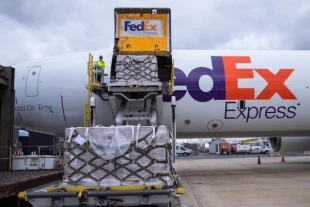
-
China’s outbound air cargo market shows signs of recovery with the 29% month-on-month volume growth in March this year followed by 2% rise in the first half of April, says Xeneta
-
The online platform’s airline analyst says there’s still room for growth as the global industry bellwether was down just 7% y-o-y in the first quarter
-
China’s outbound air cargo capacity in March rose 25% m-o-m but fell 4% in the first two weeks of April, but analyst Wenwen Zhang says growth in March was deceptive as it’s coming from a low base
China’s air cargo exports gained a further 2% in the first half of April 2023 after growing 29% month on month in March as its air cargo market showed signs of rebounding following the seasonal slowdown and Beijing’s high-profile zero-COVID policy, according to Xeneta.
The Oslo-based technology and analytics platform said on April 21 that China’s Q1 air cargo export volumes, the bellwether for the global market, were still down 7% year on year, indicating there’s still room for improvement.
Xeneta airline industry analyst Wenwen Zhang said in a blog that China’s outbound air cargo capacity in March expanded 25% m-o-m largely due to the post-Lunar New Year recovery, but dipped 4% m-o-m in the first two weeks of April.
“This shows that the airlines’ summer schedules, starting from 26 March, have yet to deliver any meaningful increase in passenger belly capacity, as shown on the transatlantic trade, with outbound international travel demand remaining subdued compared to domestic demand,” Zhang said.
Container trading platform Freightos corroborates this, saying expectations for a strong summer of transatlantic passenger travel is leading some carriers to significantly increase the number of flights on this route, expanding air cargo capacity.
Freightos Air Index for Europe-N. America rates slipped last month to US$2.61/kg, down from $3/kg at the start of the year, but that a big increase in capacity could push air cargo rates down further, said Freightos head of research Judah Levine.
Zhang said that the perceived capacity growth can be deceptive. “Due to the very low level of capacity out of China at this time last year, the year-on-year growth rates can appear impressive, despite the relatively low levels,” the analyst said.
Zhang said that in March this year, outbound air cargo capacity expanded 28% y-o-y, while in the first two weeks of April the expansion was 133% because the high growth rate came from a low base in April 2022, as it coincided with the start of a two-month lockdown in Shanghai.
RELATED READ: Uneven rally cuts airfreight rates
In terms of capacity utilization, the China export air cargo load factors eased from 93% in March to 89% in early April, although still high at 6 percentage points above pre-pandemic levels, indicating a tight supply-demand balance remains in the market, Zhang said.
She noted an interesting fact is the outbound China market is going against the tide of the general air cargo market and occurring despite the drop in the filling factor.
China air cargo exports spot rates rose 8% from the first half of March to the first half in April.
Both general and special cargo spot rates rose 2% to $3.74 per kg for the China to Europe corridor and 5% to $5.26 for the China-US route, Zhang said. In contrast, the average global air freight rate fell 2% during the period.
This is due to China’s outbound air freight rates not being driven by cost factors, but mainly by the rise in general cargo demand, Zhang said. General cargo spot rates gained 13% from the first half of March to mid-April on the China-Europe trade, and 5% on the China-US.
Peter Stallion, head of air and containers at Baltic Exchange’s Freight Investor Services, warns: “Airfreight rates could become a victim of their own successes, with orders being pulled by major retailers already over-stocked on the tail-end of the pandemic.”
Stallion said in a blog that risk abounds even with a near-term stabilization in rates. “Primary impacts [from] sustained volatility in energy and crude-oil petroleum projects with Brent crude shooting up earlier in April [due to] surprise OPEC+ cuts in output,” he said, with the pace and intensity of the Ukraine war providing a backdrop of macroeconomic instability that remains highly precarious.




